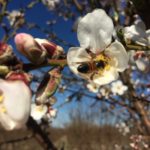 In my prior post I mentioned that this season’s shorter bloom period in the apple orchard necessitated our getting additional hives of honeybees to help pollinate. Pollination is essential in the production of many fruit, nut and vegetable crops. Without pollination of these various crops the dinner plates of most of us would lack variety, flavor and nutrition. As a grower we find it highly important to develop economical strategies to ensure pollination in our orchard. It is no trade secret that we rely heavily on honeybees. Other than honeybees, we look to other pollinators to help us out too.
In my prior post I mentioned that this season’s shorter bloom period in the apple orchard necessitated our getting additional hives of honeybees to help pollinate. Pollination is essential in the production of many fruit, nut and vegetable crops. Without pollination of these various crops the dinner plates of most of us would lack variety, flavor and nutrition. As a grower we find it highly important to develop economical strategies to ensure pollination in our orchard. It is no trade secret that we rely heavily on honeybees. Other than honeybees, we look to other pollinators to help us out too.
Having more than one type of pollinator in the orchard helps overall pollination. Different types of bees fly at different times during the day and thus are working to pollinate at different times during the bloom period. The larger bumble bee flies in rainier and cooler weather than the honeybee. Bumble bees start flying earlier in the morning and have a longer work day, sometimes even into late evening. The honeybee likes to start around eight or nine o’clock in the morning and quit by early evening. Most beekeepers put their hives in areas where early morning sun warms the hives so the bees are “tricked” into getting an earlier start. Once the honeybee is out and about it gets busy and starts to work.
Our reliance on honeybees, or “managed” bees, alternative managed bees, such as bumble bees, and wild bees for pollination is becoming a problem for us. Why? Quite simply, bees of all types are in trouble. Major studies are being conducted to determine the reason or reasons bees are threatened and dying. Parasites, as well as environmental factors were found to be contributors to a decline in the bee population. An overuse of pesticides and herbicides have created a habitat loss resulting in poor foraging areas. Bees cannot survive without their three primary needs: food (nectar, pollen and water), shelter (such as hives) and a safe environment.
We have attended several seminars sponsored by our state land grant university, Purdue, on the topic of the declining population of the honeybee in our area. While no verdicts are in yet on one definitive factor, the researchers at the University have several theories that continue to be explored. As scientists delve deeper into the problem, our ongoing challenge is trying to develop strategies to become more “pollinator” friendly. Farmers need to implement horticultural practices that support pollinators by reducing pesticide risk and cover cropping to provide flowering resources for bees to use as forage areas. Home gardeners can contribute greatly by planting more flowers, reducing use of pesticides in lawns and gardens and providing nesting areas.
